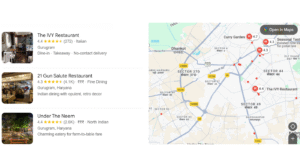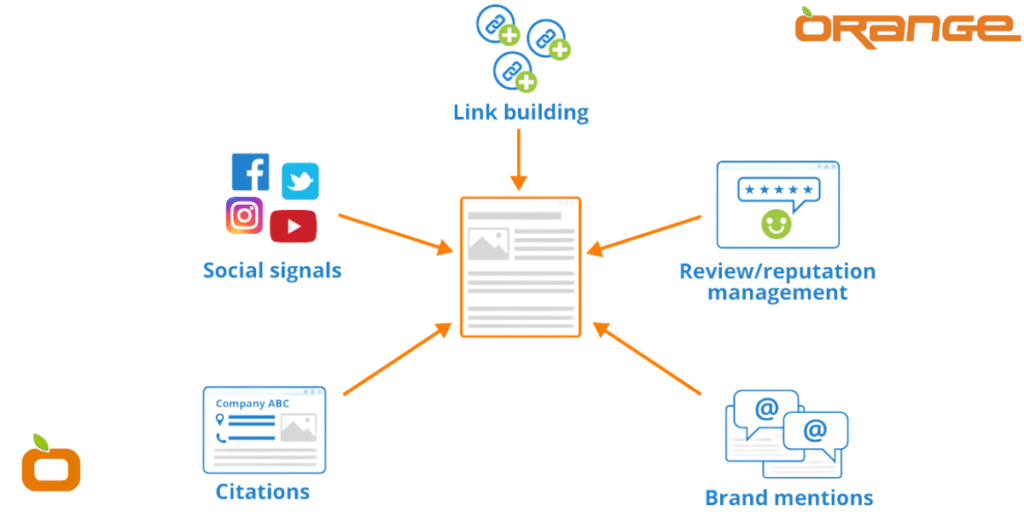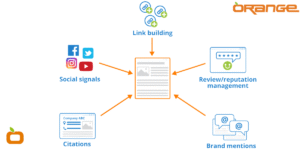
high converting landing page guide

Link building has been a cornerstone of SEO — a tactic used to increase domain authority, passing link juice, and climb the Google rankings. But the digital landscape has changed. Today, every business expects more than just better rankings; they demand measurable business growth from every marketing effort.
So here’s the big question:
What if your backlinks could drive more than just traffic? What if they could drive leads, boost conversions, and even build your brand?
That’s where strategic link building comes in — a smarter, ROI-focused approach that doesn’t just please search engines but fuels meaningful business growth. At Orange Impex, we work with Real Estate, startups, SaaS brands, eCommerce businesses, and marketing teams to create link-building strategies that support their bottom line, not just their backlink profile.
The Evolution of Link Building: From Ranking Signals to Revenue Engines
Link building started as a simple numbers game. The more links you had—no matter where they came from—the higher you ranked. Businesses flocked to directories, link farms, and blog comment sections to accumulate backlinks.
Then came Google’s Penguin update, and everything changed.
The focus shifted from quantity to quality, and the SEO world began embracing editorial backlinks, content-driven outreach, and digital PR. Today, link building is about more than SEO; it’s about visibility, authority, and trust.
Strategic link building now plays a direct role in brand positioning, demand generation, and even customer acquisition. Businesses that adapt to this evolution are the ones that turn their SEO spend into real revenue.
Share:
More Posts
Send Us A Message
What Is Strategic Link Building?
Unlike traditional link building, which focuses on volume, strategic link building is about securing high-quality backlinks from sources that are relevant, authoritative, and aligned with your business goals.
Here’s how it stands out:
- Relevance: Getting links from industry-specific websites that attract your ideal audience.
- Authority: Prioritizing placements on domains with strong trust signals (DA/DR).
- Intent: Earning backlinks through valuable content, not forced or purchased methods.
Examples include:
- Guest posts on reputable industry publications
- Mentions via digital PR campaigns
- Contextual backlinks through niche edits
- Collaborations with influencers or B2B partners
The goal isn’t just to rank—it’s to build a sustainable SEO ecosystem that powers your entire marketing funnel.
Business Benefits of Strategic Link Building (Beyond Rankings)
When done right, link building becomes a business development engine, not just a technical SEO tactic.
Builds Brand Authority & Trust
Being cited by respected websites sends trust signals—not just to Google, but to your audience too.
Drives Referral Traffic That Converts
A backlink from a niche-relevant article or review site brings targeted traffic more likely to engage and buy.
Improves Relevance in Target Markets
Backlinks from industry-relevant platforms help you appear where your audience already is.
Establishes Thought Leadership
Contributing content to leading platforms positions you and your business as experts.
Enhances B2B Relationships
Outreach-based link building fosters partnerships, guest appearances, and even new business leads.
Boosts ROI Across the Funnel
Strategic backlinks reinforce every stage of your SEO funnel—from awareness to conversion—maximizing your marketing return.
Case Study: How Link Building Helped a SaaS Company Grow Revenue by 40%
Let’s look at a real-world example.
Client: A B2B SaaS startup struggling with organic visibility and stagnant conversions.
Goal: Increase traffic, leads, and sales without paid ads.
Our Approach:
- Performed a link gap analysis against top competitors.
- Launched a content-led outreach campaign targeting SaaS directories, industry blogs, and review platforms.
- Acquired 35+ high-authority backlinks in 90 days.
Results:
- +70% increase in organic traffic
- +40% boost in monthly recurring revenue
- 3 keywords moved into Google’s top 3
- Website DR jumped from 28 to 42
This wasn’t just about SEO—it was about driving qualified traffic and closing deals.
The Strategic Link Building Framework We Use at Orange Impex
At Orange Impex, our link-building services are built on a proven, five-step framework that drives real business impact.
Research
We begin with:
- Backlink audits to assess current assets
- Competitor gap analysis
- Identifying high-authority opportunities in your niche
Strategy
- Creating a content map aligned to search intent
- Prioritizing links that support your funnel stages
- Choosing relevant anchor texts that boost SEO
Outreach
- Personalized, value-driven pitches to webmasters, editors, and journalists
- Pitch angles that position your business as a valuable source
Execution
- Coordinated content creation for guest posts
- Contextual placements with proper anchor distribution
- Strict quality control (no PBNs or spammy sites)
Reporting
- Monthly reports on:
- Link placements
- DR/DA scores
- Organic traffic and ranking shifts
- Business KPIs (leads, conversions)
- Link placements
Common Link Building Mistakes That Hurt Business Growth
Too many brands fall into traps that hurt their reputation and ROI:
- ❌ Buying low-quality, irrelevant links
- ❌ Using exact-match anchor text too aggressively
- ❌ Ignoring niche relevance
- ❌ No tracking of link performance or funnel impact
- ❌ Overlooking content quality in guest contributions
A strategic approach avoids these and ensures each link adds real value to your SEO and brand.
Why Link Building Belongs in Your Marketing Funnel
Strategic link building doesn’t operate in isolation. It enhances every stage of your marketing funnel:
- Top of Funnel (TOFU):
Guest posts and PR generate awareness. - Middle of Funnel (MOFU):
Industry links drive authority to landing pages and build trust. - Bottom of Funnel (BOFU):
Backlinks signal credibility, aiding in conversion. - Multi-channel synergy matters:
Someone reads your guest article → clicks the backlink → lands on your blog → signs up → becomes a lead.
Your backlinks should act as guideposts, driving people from awareness to action.
Final Thoughts: Build Links That Build Your Business
It’s time to shift your mindset.
Backlinks aren’t just for Google—they’re for growth.
When done strategically, link building supports brand equity, demand generation, sales enablement, and more.
So, ask yourself:
Is your current link strategy supporting your business goals—or just your ranking report?
Let’s Build Powerful Links Together
At Orange Impex, we go beyond backlinks. We craft growth-driven link building strategies that turn domain authority into business authority.
Ready to see what link building can do for your revenue?
👉 Talk to Our SEO Strategists Today
👉 Request a Custom Link Strategy



